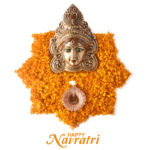Navratri 2023, the nine-night festival celebrated with great enthusiasm in India, holds profound spiritual significance. It is dedicated to various forms of the goddess Durga, each symbolizing distinct aspects of feminine power. One captivating aspect of Navratri is the association of specific colors with each day, representing different goddesses.
The Meaning of Goddess Colors
Shailaputri Devi (Day 1 – Red): Shailaputri Devi, known as the daughter of the Himalayas, represents the Muladhara Chakra or the root chakra. The color red symbolizes strength and power.
Brahmacharini Devi (Day 2 – Green): Brahmacharini Devi is associated with wisdom, intelligence, enlightenment, faith, honesty, and purity in devotion. The color green represents her attributes.
Chandraghanta Devi (Day 3 – Grey): Chandraghanta Devi, with a half-moon on her forehead, symbolizes courage, resolution, righteousness, and fearlessness. Grey reflects her fierce nature and ability to combat evil.
Kushmanda Devi (Day 4 – Yellow): Kushmanda Devi, as the creator of the universe, embodies abundance, strength, health, and fortune. Yellow signifies brightness and glory.
Skandamata (Day 5 – Orange): Skandamata resembles a mother who protects her children from evil and demons. Orange represents her qualities of wisdom, brightness, and serenity.
Katyayani Devi (Day 6 – Red): Katyayani Devi purifies sins, removes obstacles, and banishes evil energy. Red symbolizes her intense rage and strength.
Kalaratri Devi (Day 7 – Green): Kalaratri Devi, the destroyer of demons Chandha and Mundha, is associated with the Crown Chakra and the color green, signifying transformation and power.
Maha Gauri Devi (Day 8 – Dark Blue): Maha Gauri Devi, also known as Shwetambardhara, offers sustenance, vitality, strength, harmony, and motherhood. Dark blue represents her immense power.
Siddhidharti Devi (Day 9 – Pink): Siddhidharti Devi, a manifestation of Goddess Saraswati, is known for her spiritual and meditation abilities, granting mental stability and peace. Pink symbolizes compassion and purity.
During Navratri, these colors not only adorn the goddess but also influence attire and decorations, infusing each day with its unique energy and significance. This celebration is a vibrant tapestry of devotion, culture, and spirituality, where colors play a vital role in honoring the divine feminine in all her glory.







